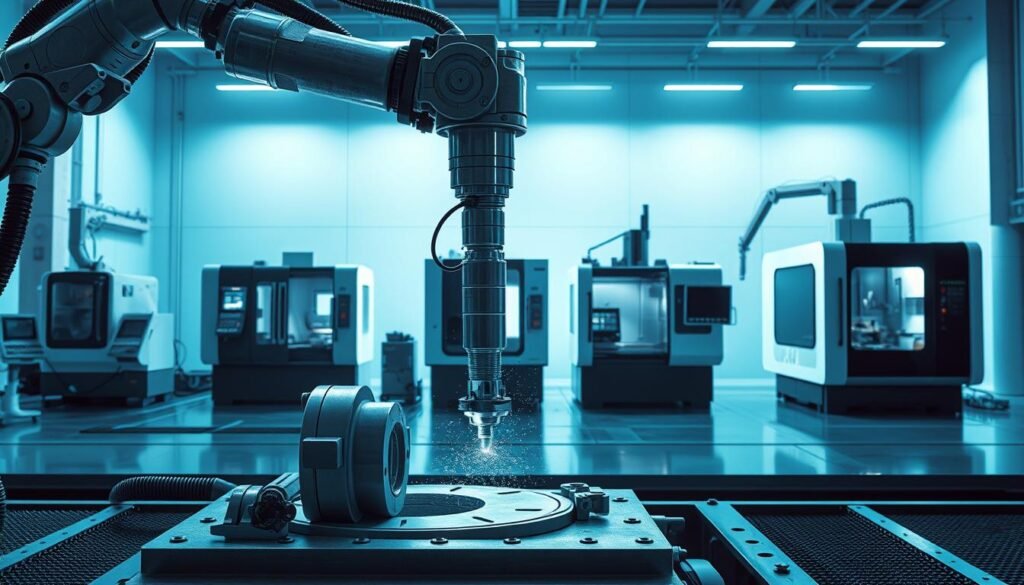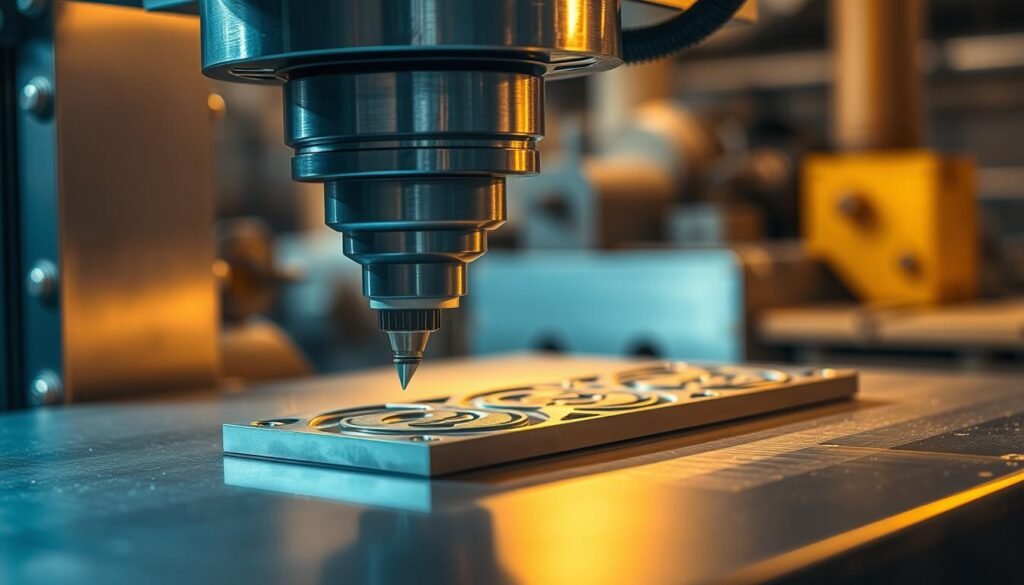In our fast-moving world, full of tech advances, precision is key. CNC precision machining leads the charge. It turns complex designs into reality with unmatched accuracy. Imagine machines in our daily lives working flawlessly, thanks to this tech.
This process starts with a computer turning designs into real, precise parts. CNC machining isn’t just about keeping up; it’s about setting new high standards. It lets us create super accurate parts, essential in many fields like aerospace and healthcare.
RapidDirect shows how perfection is now something you can order, thanks to advanced CNC machines. CNC machining is crucial, no matter the project size. Now, let’s dive into how this all works and why it’s so important for modern engineering.
Key Takeaways
- Advanced machining technology enables the production of highly precise components essential for critical applications.
- CNC precision manufacturing combines computer-controlled precision with automated processes to produce uniform parts.
- Innovations in software and equipment have made CNC machining integral in custom and high-volume production settings.
- The stringent tolerances achieved through precision machining translate into reliability and performance in end-use applications.
- Adoption of advanced multi-axis CNC machines reflects a commitment to quality and cost-effectiveness in the manufacturing sector.
What is CNC Precision Machining
Computer Numerical Control (CNC) Precision Machining is the art of using computers to control machine tools. This method helps make precision-machined parts and is vital in many fields. Because of CNC, machines can make parts with exact measurements.
CNC machining is special because machines work on their own, doing tasks too tough for people. Machines like milling machines, lathes, and grinders are part of CNC. They follow exact digital designs from software like CAD and CAM, to cut materials perfectly.
In industries like automotive, aerospace, medical, and electronics, making mistakes isn’t an option. CNC shines here by making items like turbine blades and engine parts with high accuracy. For more details, see CNC precision machining.
But CNC Precision Machining isn’t just about making things to the right size. It also makes making things faster, wastes less material, and helps the planet. Thanks to new tech in CNC, making things has gotten even better, changing how we make stuff all over the world.
The Advent and Evolution of CNC Precision Machining
The evolution of machining marks a key era in manufacturing. It highlights the move from manual labor to CNC automation. This change has reshaped production in various industries.
From Manual to Automation: The Shift to CNC
The move to manual to computer-controlled gear brought a big change in machining. Originally, manual work depended a lot on the operator’s skill. But, CNC machines transformed operations with their precision.
CNC systems use detailed codes to automate complex tasks. This reduces mistakes and increases both accuracy and consistency.

CNC automation boosts precision, speed, and efficiency. It significantly helps in reaching productivity targets.
The Technological Milestones in CNC Precision Machining
Technology has gone from simple CNC designs to advanced machines like multi-axis and EDM. These changes are not just in machine power. They also push the limits of what’s possible in machining.
CNC technology is used in many processes like milling and grinding. Advances in software, like CAD and CAM, have optimized these processes.
The shift from manual to computer-controlled machining is not just about better machines. It’s also about better software. This software doesn’t just run the machines but helps with complex simulations and making changes in real time, improving design and manufacturing.
Key Components and Equipment of CNC Machining
In the manufacturing world, using CNC machinery, CAD modeling, and CAM systems marks a modern method in engineering. This mix is critical, touching all stages from design to actual making.
CAD software is key in making detailed 3D designs needed for accurate machining. After that, CNC programming uses these designs to set up the machines. This shift from planning to making is smoothed out by CAM systems. These systems turn CAD designs into machine instructions, ensuring items are made right and fast.
Our CNC gear comes with Automated Tool Changing to boost how well we work. This lets us swap tools quickly, cutting down on stops and keeping production moving. We’ve got all kinds of CNC gear, like milling machines, lathes, and drills, to work on many materials and shapes. For flat parts, we use milling machines. Lathes are best for round items.
If a business wants to up its making game, combining CAD, CAM, and top-tier CNC machines with Automated Tool Changing is top-notch. These tools let us make complex designs very precisely. This matters a lot in fields where being exact is key.
- CNC machinery means we can make things precisely and in big amounts.
- CAD modeling makes designing faster and more accurate.
- CAM systems turn digital plans into actual products.
- Automated Tool Changing in CNC machines cuts down on waiting and boosts work speed.
Getting how these technologies work together and choosing the right mix for a project shows our promise to make things precisely. By mastering such advanced gear and tech, we keep our name high for skill and new ideas in making.
Materials and Their Impact on Precision CNC Machining
Choosing the right materials is key in precision CNC machining. Materials’ traits like thermal stability, hardness, and how well they can be machined affect efficiency and results. It’s vital to pick the best CNC metals and plastics to ensure top-notch CNC plastic machining quality.
Metals and plastics are both crucial in various industries for their unique qualities. Metals are strong and durable. In contrast, engineered plastics can be molded easily and don’t rust.
| Material Type | Common Uses | Advantages | Considerations |
|---|---|---|---|
| Metals (Aluminum, Steel, Titanium) | Aerospace, automotive manufacturing | High strength, good thermal conductivity | Requires precise cooling during machining |
| Engineered Plastics (Nylon, PEEK) | Medical devices, electronic housings | Lightweight, corrosion-resistant | Sensitivity to heat during CNC plastic machining |
Understanding the specific needs of a project is crucial for CNC machining. Choosing between metals and engineered plastics affects the product’s precision, cost, and performance. Each material has its benefits and challenges.
Applications and Industries Relying on CNC Precision Machining
Our company understands the big role CNC precision machining has in key areas. These include automotive, aerospace, medical devices, and electronics. Each one requires the best in precision and reliability.
Automotive and Aerospace: Precision at the Core
In the automotive world, CNC automotive components are crucial. They include engine parts and transmission systems. CNC machines make sure every part is made perfectly. The aerospace industry also depends on this for parts like turbine blades and cockpit instruments.
Medical Devices and Electronics: The Need for Accuracy and Reliability
When it comes to medical devices, CNC machining makes vital parts. These include orthopedic implants and surgical tools. Accuracy here is key for safety and procedure success. The electronics sector also benefits from CNC. It helps make small but complex parts that keep our devices running well.
So, we’re always working to use the latest CNC tech in many fields. This helps us push limits in precision engineering applications. It also makes us a leader in high-accuracy manufacturing.
The Fine Line Between CNC Machining and Precision Machining
The difference between CNC machining and precision machining is key in industries where errors must be tiny. Both methods are crucial in modern manufacturing. Yet, they differ in how closely they follow machining tolerances and in the precision of the parts made.
Machining tolerances set the allowed variation in size and are vital in separating precision machining from CNC. At our company, CNC precision capabilities mean more than meeting these tolerances. We aim to surpass the standards in precise manufacturing processes.

Understanding Tolerances: Precision CNC Machining Capabilities
Precision machining works with tighter tolerances, up to ±0.001 inches. Such accuracy is crucial for products that require extreme detail. This is especially true for the aerospace and medical fields, where a small error could lead to serious problems.
Comparative Analysis: When to Employ CNC Precision Machining
The choice to use CNC precision machining depends on the design’s complexity, the material, and the needed precision. High-precision parts often require our advanced CNC techniques. This is particularly true when the tolerances needed are beyond what standard machining can achieve.
Ultimately, our advanced machines allow for better control in making products. This ensures they meet the strict standards required by crucial industries. Our dedication to using the latest technology and improving our methods is key to our mission. We aim to deliver unmatched precision in every part we make.
Challenges and Future Directions in CNC Precision Machining
In the world of CNC precision machining, we tackle manufacturing challenges that test the limits of material engineering. Achieving this requires constant precision machining innovation. Overcoming these challenges lets us stay ahead in the competition and move towards a tech-savvy future.
Overcoming Material and Design Limitations
Dealing with material limits and complex designs is a big challenge in CNC machining. As technology grows, so does the difficulty of what we’re asked to make. This situation needs us to not just understand materials better but also to be flexible in how we make things.
We’ve started using newer materials that are stronger and fit complex designs better. Plus, by researching and adapting in material engineering, we’ve created new alloys and composites. These are made just for advanced CNC machining tasks.
Technological Innovations and Their Adoption in the Field
Precision machining innovation is crucial for overcoming current manufacturing issues. A bunch of new tech is beginning to change our field:
- Advanced simulation software for better accuracy and less waste
- AI integration to make machining processes more efficient
- Techniques for optimizing tool paths to ensure top-notch accuracy and surface quality
Looking into the future, using these new tech solutions will transform CNC precision machining. This change will let us tackle more complicated tasks better and faster. It will also tackle current manufacturing problems with smarter, faster methods.
Conclusion
We have dived deep into CNC precision machining and seen how it changes manufacturing. This mix of computer control and machine power has raised the bar for making things precisely. Thanks to advanced CNC, we can now make complex parts very reliably, unlike with manual methods.
CNC precision machining is key to our goal of offering top-notch manufacturing solutions. The blend of the latest tech and our know-how meets high precision needs. This dedication helps us keep giving great services and products to our clients.
The future of making things is tightly tied to CNC precision machining progress. For companies wanting to stay ahead, adopting these new methods is crucial. Indeed, as the field grows, using the newest CNC tech becomes essential for leading in quality and excellence.
FAQ
What is CNC Precision Machining?
CNC Precision Machining uses computers to control tools for making parts with great accuracy. It relies on CAD/CAM software for design and instructions. This way, machines can create detailed parts quickly and precisely.
How has CNC Precision Machining evolved over time?
CNC Precision Machining has grown from manual to automated operations. Now it uses technologies like multi-axis CNC, EDM, and plasma cutters. These advancements have boosted its precision, speed, and ability to make complicated shapes.
What are the key components in a CNC machining setup?
A CNC setup mainly includes CAD software for design, CAM systems for instructions, and various CNC machines. Machines like mills, lathes, and drills work together to create precise parts.
What materials are used commonly in Precision CNC Machining?
Precision CNC Machining often uses strong metals like aluminum, steel, and titanium. It also uses plastics and composites, like Nylon and PEEK, based on the product’s needs and environment.
Which industries require the precision of CNC Machining, and why?
The automotive, aerospace, medical, and electronics industries all need CNC Machining. They rely on it for high-quality parts with tight tolerances, from engine parts to surgical tools.
How do Precision Machining and standard CNC Machining differ?
Precision Machining can achieve tighter tolerances, sometimes as exact as ±0.001 inches. This level of precision is essential for highly accurate and consistent applications.
What are the challenges faced in CNC Precision Machining?
CNC Precision Machining challenges include working with difficult materials, complex designs, and the push for innovation. Overcoming these requires advanced skills and new manufacturing techniques for precision and efficiency.
What future technological innovations are likely to impact CNC Precision Machining?
Future innovations may involve AI, advanced simulations, optimizing tool paths, and using new materials. These changes aim to improve the accuracy, speed, and handling of complex projects in CNC Precision Machining.




